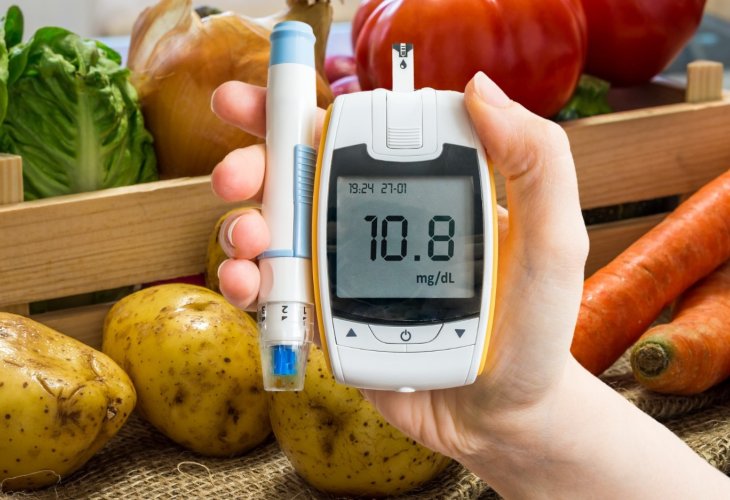How to Manage Diabetes During Passover
Passover poses a significant challenge for diabetics, who need to balance between carb-heavy meals and maintaining stable blood sugar levels.
 (Photo: shutterstock)
(Photo: shutterstock)The calorie and carb bombardment that begins on the Seder night and continues throughout the holiday meals makes Passover a challenging holiday for anyone watching their weight, especially for those with diabetes, as they must maintain stable blood sugar levels. Considering the holiday's flagship dish, matzah, each matzah contains twice the calories and carbs of a slice of bread and is less filling, leading to increased consumption. Additionally, there are the kneidlach—a single, medium-sized piece contains about 100 calories and counts as a carbohydrate portion. But who among us settles for just one?
Besides all the traditional foods during Passover, the mitzvah is to drink four cups of wine or sweet grape juice. However, it's crucial to remember that each cup of grape juice is rich in simple sugars, which are quickly absorbed into the blood and spike sugar levels. The sweet Kiddush wine contains even more sugar, in addition to alcohol, so it's preferred to limit to just one sip. For other beverages during the meal, it's best if they're low-calorie: water with ice cubes, mint leaves, and lemon slices in a transparent jug make a refreshing drink and colorful decoration for the holiday table.
A sugar-free peanut snack contains about 4 grams of carbs per unit, a sugar-free sesame snack contains about 10 grams of carbs per unit, and the famous Passover flower cookies we all know contain about 16 grams of carbohydrates but also a significant amount of sugar.
Additionally, it's important to address the baking aspect of Passover: there are various types of flour available in the market that do not contain wheat, such as corn flour, chickpea flour, potato flour, quinoa flour, and soy flour. The most quality choice is soy flour, as it contains the smallest amount of carbohydrates—30 grams of carbohydrates per 100 grams, compared to 60-90 grams in other types of flour and 80 grams of carbohydrates per 100 grams of regular matzah flour.
So how do you get through the holiday meal safely?
- Several hours before the holiday meal, it's recommended to engage in physical activity. This activity often results in lower blood sugar levels for several hours afterward. Alternatively, you can take a walk after the meal (though not immediately after) for the same reason.
- Stick to your medication treatment plan.
- Ask your hosts what the planned menu is for the holiday meal. This way you can plan in advance which dishes to choose or check the carbohydrate content in a particular dish (e.g., how many carbs are in the kneidlach).
- Prepare one dish / meal that you know the nutritional composition of. Preferably, the dish should be low-carb and consists mainly of vegetables / proteins.
- If you've finished the plate you served yourself (including appetizers before), get up from the table, help clear, or sit next to someone else who has finished eating. This way, you won't continue to eat just because the food is on the table, as this usually leads to an additional rise in blood sugar levels and may require additional insulin.
- Among the variety of desserts, choose the one you most desire and share it with another person. If you can settle for a square of dark chocolate with 85% cocoa as a dessert, this is the best choice you can make. If you choose to drink alcohol, limit the amount and remember that "clean" alcohol tends to lower sugar levels. For this reason, monitor your sugar levels several hours after the meal.
- Choose unsweetened drinks like water, soda, diet soda, etc.
- Limit the amount of carbs you eat during the meal, as they primarily affect blood sugar levels. Examples of carbs: rice, potatoes, Passover kosher pasta, kneidlach in soup, matzah, etc.
Clip and Keep:
Regular matzah: 140 calories, 32 grams of carbs per unit.
Light matzah: 100 calories, 20 grams per unit.
Charoset: About 50 calories and 5-8 grams of carbs per tablespoon.
Maror: Can be eaten freely, without restriction.
1/2 egg: 40 calories, no carbohydrates.
Medium baked potato: 100 calories, 20 grams of carbs.
Two kneidlach and soup: 220 calories.
Coconut/peanut cookie: 100 calories per unit, high in fat.
Cup of grape juice: 80 calories, 20 grams of carbs.
Slice of Passover cake: at least 250 calories (in a thin slice), 30-40 grams of carbs.
Gefilte fish portion: 100-150 calories, low in carbs if no sugar is added.
Einat Mazor Bakar is a clinical dietitian at the obesity clinic at DMC Diabetes Treatment Center.

